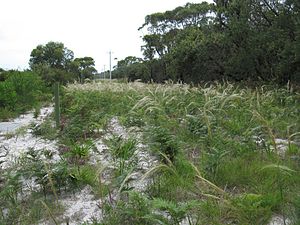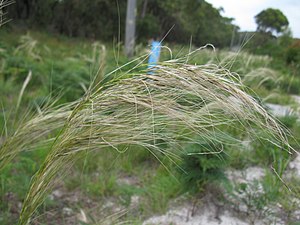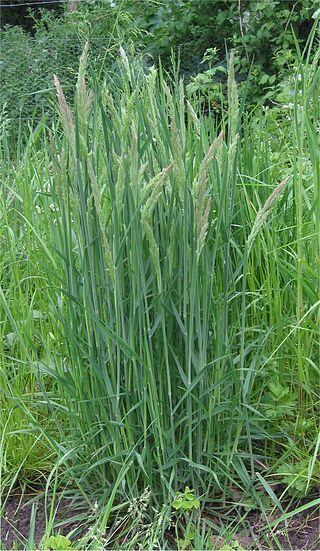
Holcus lanatus is a perennial flowering plant in the grass family Poaceae. The specific epithet lanatus is Latin for 'woolly' which describes the plant's hairy texture. Common names include Yorkshire fog, tufted grass, and meadow soft grass. In North America, where it is an invasive species, names include velvet grass and common velvet grass.

Themeda triandra is a species of C4 perennial tussock-forming grass widespread in Africa, Australia, Asia and the Pacific. In Australia it is commonly known as kangaroo grass and in East Africa and South Africa it is known as red grass and red oat grass or as rooigras in Afrikaans. Kangaroo grass was formerly thought to be one of two species, and was named Themeda australis.

Nassella pulchra, basionym Stipa pulchra, is a species of grass known by the common names purple needlegrass and purple tussockgrass. It is native to the U.S. state of California, where it occurs throughout the coastal hills, valleys, and mountain ranges, as well as the Sacramento Valley and parts of the Sierra Nevada foothills, and Baja California.

Bromus hordeaceus, the soft brome, is an annual or biennial species of grass in the grass family (Poaceae). It is also known in North America as bull grass, soft cheat, and soft chess.

Austrostipa is a primarily Australian genus of plants in the grass family, commonly called speargrass.

Eriocoma parishii is a species of grass known by the common name Parish's needlegrass.
Austrostipa variabilis is a species of grass in the family Poaceae that grows in southern parts of Australia.
Austrostipa crinita is a species of grass that grows in coastal parts of midwest Western Australia.

Setaria viridis is a species of grass known by many common names, including green foxtail, green bristlegrass, and wild foxtail millet. It is sometimes considered a subspecies of Setaria italica. It is native to Eurasia, but it is known on most continents as an introduced species and is closely related to Setaria faberi, a noxious weed. It is a hardy grass which grows in many types of urban, cultivated, and disturbed habitat, including vacant lots, sidewalks, railroads, lawns, and at the margins of fields. It is the wild antecedent of the crop foxtail millet.
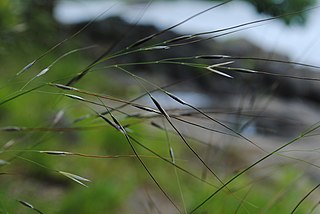
Piptochaetium avenaceum, commonly called black oat grass, blackseed needle grass or blackseed speargrass, is a species of perennial bunchgrass native to eastern North America. It is a member of the grass family Poaceae.

Boronia mollis, commonly known as soft boronia, is a plant in the citrus family and is endemic to New South Wales. It is a shrub with pinnate leaves, and small groups of pink flowers in leaf axils. It grows in coastal areas in forest.

Hakea tephrosperma commonly known as hooked needlewood, is a shrub or small tree species in the family Proteaceae. It has cream flowers, needle-shaped leaves and is one of the taller species adaptable for dry to temperate locations.

Poa labillardierei, also known as common tussock-grass, is a species of tussock grass that is endemic to Australia. It is found in southern and eastern Australia, including Tasmania. There are differing variations, Poa labillardierei var. acris Vickery and Poa labillardierei Steud. var. labillardierei.

Digitaria insularis is a species of grass commonly known as sourgrass. It is native to Central and South America and the southern parts of the United States and has been introduced into other parts of the world. It was first described by the German botanist Friedrich Karl Georg Fedde in 1904.

Fimbristylis dichotoma, commonly known as forked fimbry or eight day grass, is a sedge of the family Cyperaceae that is native to tropical areas.
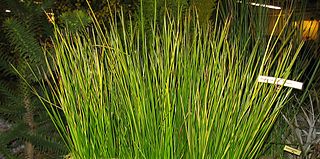
Machaerina rubiginosa, commonly known as soft twig rush, flat leaf twig rush or common twig rush, is a flowering plant in the sedge family, Cyperaceae, that is native to Asia and the Pacific.

Rytidosperma bipartitum, the leafy wallaby grass, is a perennial species of grass found in south eastern Australia. Usually found on the heavier clay or on loamy soils in open eucalyptus woodland. The habit is somewhat variable, erect and densely tufted. The grass may grow up to 0.7 m tall.

Austrostipa hemipogon is a tufted, perennial grass (a member of the family Poaceae. It is native to Australia, and found in Western Australia, South Australia, Victoria, and Tasmania.

Austrostipa scabra known as speargrass, is a widespread species of tussock grass found in southern and central Australia. Speargrass stems may reach 15 centimetres (5.9 in) tall, with stems up to 60 centimetres (2.0 ft) tall. There are two subspecies, scabra and falcata.
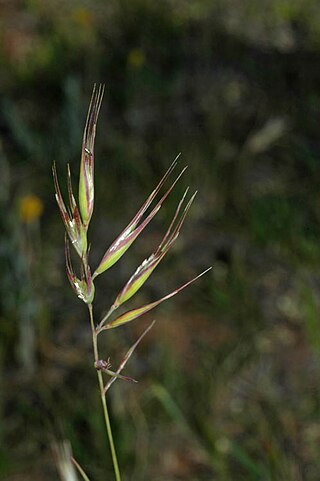
Rytidosperma erianthum, the hill wallaby grass, is a perennial species of grass found in south eastern Australia. Usually found in drier areas in a variety of habitats. The habit is somewhat variable, erect and densely tufted. The grass may grow up to 0.7 m tall.

